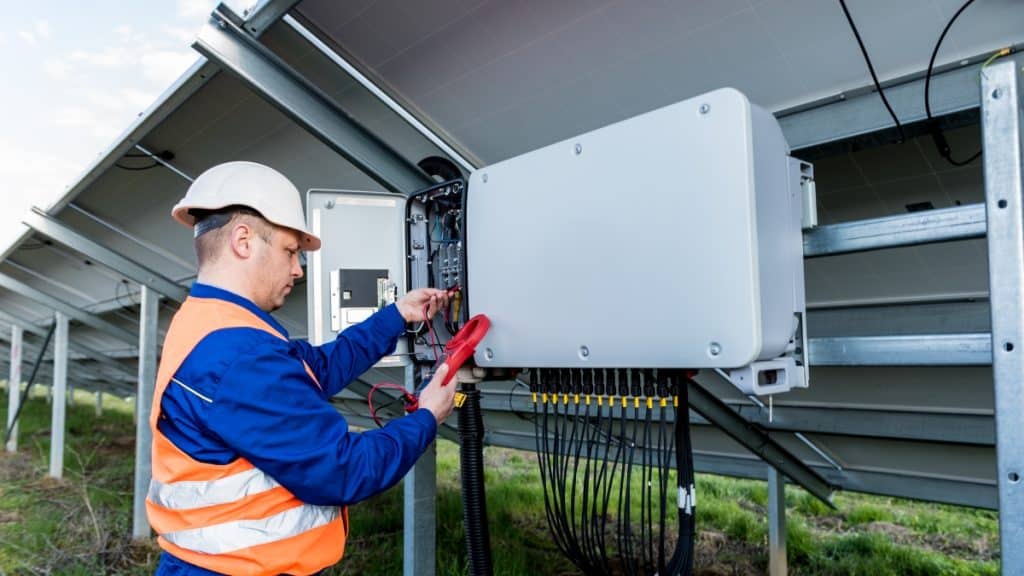When considering a solar energy system for your home, choosing the right type of inverter is crucial. The inverter is the heart of your solar installation, converting the direct current (DC) produced by your solar panels into alternating current (AC) that powers your home. There are three primary types of inverters to choose from: string inverters, microinverters, and power optimisers. Each has its unique advantages and is suitable for different scenarios. So with all this in mind, how do you determine which is best for your solar system?
Understanding the Basics
1. String Inverters
String inverters are the most common type used in residential solar systems. They are named after the “string” of solar panels that are connected to them. In this setup, the panels are wired together in series, and all the energy produced by the panels is sent to a single inverter that converts the DC electricity into AC.
Pros:
- Cost-effective: String inverters are generally more affordable upfront compared to other types.
- Simplicity: With fewer components, string inverters are easier to maintain.
- Proven technology: String inverters have been around for a long time and are known for their reliability.
Cons:
- Shading issues: If one panel in the string is shaded or underperforming, it can affect the entire system’s output.
- Less flexibility: System design is less adaptable to complex roof layouts.
2. Microinverters
Microinverters are installed directly on each solar panel, converting DC to AC at the source. This means each panel operates independently, which can be a significant advantage in certain situations.
Pros:
- Maximised energy production: Since each panel operates independently, shading or a fault on one panel won’t affect the others.
- Scalability: Ideal for complex roofs or if you plan to expand your system in the future.
- Enhanced monitoring: Microinverters allow for panel-level monitoring, giving you detailed insights into system performance.
Cons:
- Higher cost: Microinverters are more expensive upfront, both in terms of equipment and installation.
- Increased complexity: With more components, there’s a slightly higher chance of something going wrong.
3. Power Optimisers
Power optimisers are a hybrid solution. They are paired with each solar panel (similar to microinverters) but instead of converting DC to AC at the panel, they “optimise” the DC electricity before sending it to a central string inverter for conversion.
Pros:
- Improved energy yield: Like microinverters, power optimisers mitigate the impact of shading or mismatched panels.
- Cost-effective: Typically less expensive than microinverters while offering similar benefits.
- Enhanced safety: Some power optimisers include advanced safety features that reduce DC voltage during shutdown.
Cons:
- More components: While not as complex as microinverter systems, power optimisers still add additional components compared to string inverters.
- Dependence on a central inverter: If the central inverter fails, the entire system goes down.
Which is Best for You?
The best inverter choice depends on your specific needs and circumstances. Here’s a breakdown to help guide your decision:
- For straightforward installations with limited shading: A string inverter is likely the most cost-effective option.
- For roofs with shading or multiple orientations: Microinverters or power optimisers can help maximise energy production.
- For complex roof designs or future expansion: Microinverters offer excellent flexibility and scalability.
- For those looking for a balance between cost and performance: Power optimisers provide a middle ground, offering enhanced performance without the higher cost of microinverters.
Additionally, it’s essential to ensure that your chosen system complies with local regulations and standards. If you’re living Down Under, consider Australian compliant residential solar inverters from trusted manufacturers like SolarEdge, known for their innovative solutions that meet the highest industry standards.
Final Thoughts
Choosing the right inverter is a critical step in designing your solar energy system. Each type – string inverters, microinverters, and power optimisers – has its own set of advantages, depending on your specific situation. By carefully considering your roof layout, shading, budget, and future expansion plans, you can select the inverter that best meets your needs and ensures optimal performance from your solar investment.
